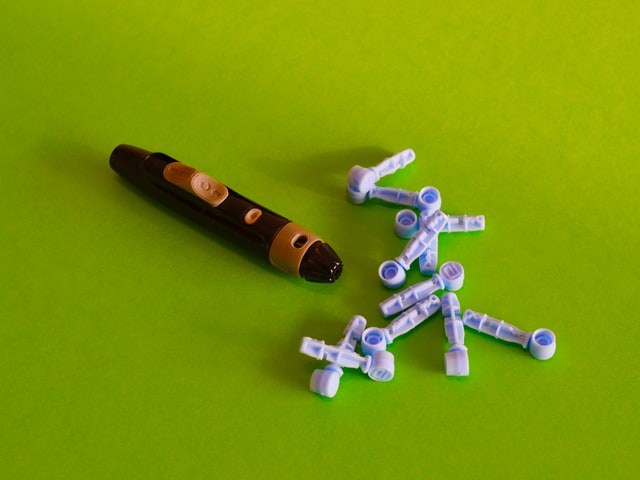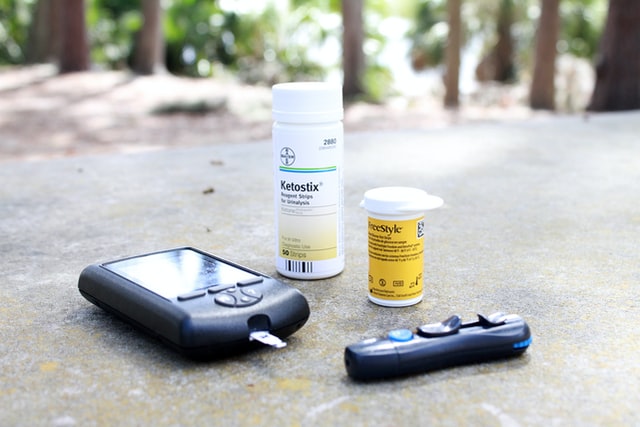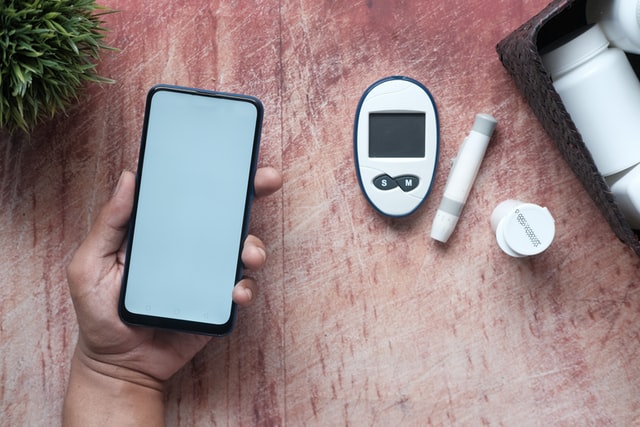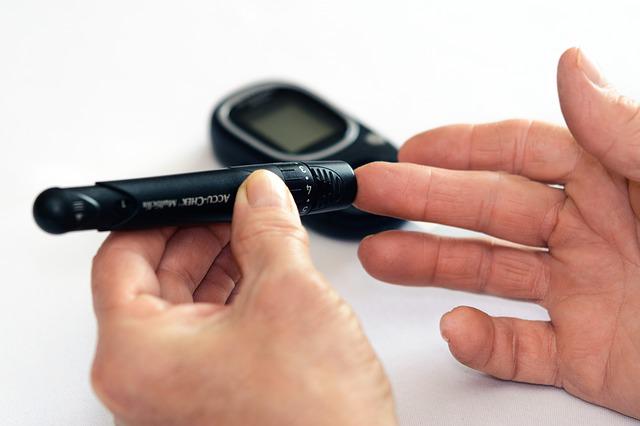
Diabetic ketoacidosis (DKA) is a severe complication of diabetes which arises when the body produces abnormally high levels of acids in the blood called ketones. It develops when the body is forced to break down fats for use as energy due to low sugar levels in the cells, which is the result of high blood sugar and low insulin.
Normally, the body’s preference for energy is sugar (glucose), but when there is insufficient insulin in the body to drive sugar from the blood into the cells for use as an energy source, the body is forced to use fats instead. Normal levels of ketones are not dangerous, however, rapid production of ketones can lead to very high concentrations in the blood which then becomes dangerous to the health.
People with type 1 diabetes are those most prone to develop DKA, though some people with type 2 diabetes can also be (2, 3).
DKA is commonly caused by missing one’s insulin shots, using clogged insulin pumps or taking the wrong insulin dose. It can also be caused by illness, which affects a person’s food and drinks intake, consequently making blood sugar control difficult to manage. Other less common causes include alcohol or drug use, heart attack or stroke, physical injury (from a car accident for example), some medicines, like some diuretics (like water pills) and corticosteroids (used to treat inflammation in our bodies) (2).
DKA normally develops slowly with some early symptoms such as extreme thirst and increased urination. If untreated, symptoms can worsen and include fast, deep breathing, fruity-smelling breath, headaches, muscle aches/stiffness, flushed face, dry skin and mouth, increased fatigue, stomach pain, nausea, and vomiting. For those who haven’t been diagnosed yet, the symptoms of DKA appear as the first symptoms of diabetes (2).
Complications of diabetic ketoacidosis

- Hypoglycemia. Hypoglycemia is a condition in which the sugar (glucose) level in the blood is lower than normal standard levels. A normal fasting blood glucose level ranges from 3.9 mmol/L (70 mg/dL) to 5.6 mmol/L (100 mg/dL). Fasting blood glucose level lower than 3.9 mmol/L (70 mg/dL) is classified as hypoglycemia. People with hypoglycemia usually experience symptoms such as dizziness, blurred vision, sweating, and palpitations amongst others (4).
- Hypokalemia. Refers to a condition of low levels of potassium in the bloodstream. Potassium concentrations in the bloodstream are very important as potassium plays a crucial role in transporting electrical signals from one nerve cell to the other. It is therefore vital in the smooth functioning of muscle and nerve cells, especially muscle cells of the heart. Low potassium levels can cause irregular heart rhythms, which are very lethal, especially in patients with myocardial infarction (heart attack) or stroke (5). Normal blood potassium level ranges from 3.6 mmol/L to 5.2 mmol/L. Blood potassium level lower than 3.6 mmol/L is considered hypokalemia, and a level lower than 2.5 mmol/L requires immediate attention as it is life-threatening. Hypokalemia can cause cardiac disease, renal failure, shock, and malnutrition (5, 6).
- Brain edema. Brain edema is swelling of the brain due to excess fluid entrapped in the brain tissues. This swelling increases intracranial pressure (the pressure inside the skull) decreasing blood flow to the brain, thus impairing brain function which can be fatal. Symptoms of brain (cerebral) edema include dizziness, headaches, numbness, lack of coordination, difficulty speaking, seizures, memory loss, mood swings, coordination impairment, vision changes or loss, difficulty breathing, and weakness (7).
- Pulmonary edema. Pulmonary edema is the swelling of the lungs due to abnormal entrapment of fluid in the air sacs of the lungs – the alveoli. It causes breathing difficulty resulting in shortness of breath. Other symptoms include wheezing breathing, palpitations, feeling like you are drowning, anxiety, cold and clammy skin or skin that looks blue or grey, dizziness, feeling lightheaded, and weakness which can cause a fall in blood pressure (8).
- Kidney failure. Kidney failure happens when the kidneys stop working well, meaning they have lost their ability to filter/remove waste from the blood and balance fluids. People with kidney failure tend to survive by using dialysis or by doing a kidney transplant. Kidney failure come with symptoms like increased urination, foamy urine, skin rashes, swelling in the ankles and feet, muscle cramps, difficulty falling asleep or staying asleep, difficulty catching one’s breath, upset stomach, vomiting, and not feeling hungry (poor appetite) or metallic taste when eating food (9).
- Loss of consciousness. Loss of consciousness is a state in which a person lacks recognition of themselves or their surrounding environment. It is popularly referred to as fainting or passing out, a posture in which the person becomes not responsive. Loss of consciousness in diabetic acidosis occurs because the brain receives insufficient glucose due to hypoglycemia, to enable its to function (10).
- Coma. DKA that is prolonged and untreated can plunge the patient into a coma called a diabetic coma. A diabetic coma can cause permanent brain damage or even death (11).
Diagnosis

DKA as earlier mentioned is characterized by abnormally high ketone concentrations in the bloodstream. Thus, testing for ketone concentration in one’s body will give clarity on whether a person is in ketosis or not. If your blood glucose level is higher than normal (like 14 mmol/L or 250 mg/L) or you are feeling sick, you can conduct a ketone test at the doctor’s office or at home using a home ketone test kit. You can test for ketones in either your blood or in your urine every 4 – 6 hours (12, 13).
- Urine ketone test. Purchase a urine ketone test kit from a drug store, then urinate into a clean container, deep in the test strip into the container containing your urine (or hold it under your urine stream), pull out the strip, shake it and observe the colour change. Compare the colour change against the chart that comes with the test kit and see the corresponding ketone level. The results will either mean no ketones, trace amounts of ketones, moderate levels of ketones, or large amounts of ketones.
- Blood ketone test. Purchase a blood ketone test kit from a drug store, insert one test strip all the way into the meter till movement stops, wash your hands with clean water and soap, and prick your finger using the lancing pin. Let a drop of blood from your finger go into the hole on the testing strip and observe the meter to read the results which will be displayed. The results can be read as follows.
- Less than 0.6 = normal
- 0.6 – 1.0 = slightly high (could imply ketones have begun to build up, indicating you probably have missed an insulin shot, which you should take immediately and do another test within 4 – 6 hours)
- 1.0 – 3.0 = moderately high (indicative of DKA, which requires immediate medical attention)
- Higher than 3.0 = very high (DKA, requires immediate medical attention like going to the emergency room or calling your doctor).
Treatment

DKA if attended to immediately, can be stopped, consequently inhibiting its complications. Treatment involves the following (2).
- Drinking plenty of water and other fluids (sugar-free and non-alcoholic beverages), to help replace that which you have lost through recurrent urination. Drinking plenty of water will also help dilute the excess sugar in your bloodstream.
- Taking insulin. Insulin will drive glucose from your bloodstream into your body cells, where they will be used for energy rather than fat, thus reducing and reversing ketoacidosis.
- Giving electrolytes, like potassium is vital for the smooth function of the brain, nerves, muscles, and heart cells.
- Taking medications for any underlying illnesses like antibiotics for bacterial infections could have triggered the body to go into acidosis.
Prevention

DKA can be prevented by living a very controlled lifestyle (2, 3).
- Regular blood sugar level checkup. Keeping a home kit to regularly check one’s glucose level is very vital in preventing the onset of DKA especially when sick. Monitoring your sugar level appropriately is the only way to ensure it stays within your target range. On average, measure and record your blood sugar levels at least three to four times a day.
- Take medications as often as have been prescribed even when you feel alright.
- Take insulin or other oral diabetes medicines as prescribed.
- Ensure you do not take expired insulin by always to checking out the expiring dates on your insulin bottles.
- Always ensure your insulin’s quality has not been tampered with. Discard any insulin that has clumps, as good insulin should either be very clear or cloudy with evenly distributed particles.
- Eat healthy meals (follow an adequate diabetic meal plan) and exercise regularly to keep your diabetes under control.
- Check your ketone level regularly as well especially if you are ill or stressed, and act accordingly.
- If you are using insulin pumps, ensure they are functioning properly (ensure it is not clogged or leaky). Also, make sure the tube connection is free of air bubbles. Any malfunctioning pump can interfere with your insulin supply, which can trigger DKA.
Diabetic ketoacidosis is a very serious complication of diabetes that can be deadly if not treated. Ketones increase the acidity of the blood, causing damage to other body organs that are vital for life like the brains, kidneys, and lungs. Treatment can be done, by administering fluids, insulin, electrolytes, and other medicines.
It can also be prevented by closely monitoring one’s glucose level regularly, measuring one’s blood or urine ketone levels regularly, eating well, exercising regularly, taking insulin appropriately and seeking medical care in case of detection of high ketone levels in the bloodstream.
REFERENCES
- CDC. (2022b, March 2). What is diabetes? Retrieved May 23, 2022, from Centers for Disease Control and Prevention website: https://www.cdc.gov/diabetes/basics/diabetes.html
- CDC. (2021, April 2). Diabetic ketoacidosis. Retrieved May 23, 2022, from Centers for Disease Control and Prevention website: https://www.cdc.gov/diabetes/basics/diabetic-ketoacidosis.html
- Diabetic ketoacidosis. (n.d.). Retrieved May 23, 2022, from Mayo Clinic website: https://www.mayoclinic.org/diseases-conditions/diabetic-ketoacidosis/symptoms-causes/syc-20371551
- Mean fasting blood glucose. (n.d.). Retrieved May 23, 2022, from Who.int website: https://www.who.int/data/gho/indicator-metadata-registry/imr-details/2380
- Low potassium (hypokalemia). (2020, July 11). Retrieved May 23, 2022, from Mayo Clinic website: https://www.mayoclinic.org/symptoms/low-potassium/basics/definition/sym-20050632
- Castro, D., & Sharma, S. (2022). Hypokalemia. StatPearls Publishing.
- Brain swelling. (n.d.). Retrieved May 23, 2022, from WebMD website: https://www.webmd.com/brain/brain-swelling-brain-edema-intracranial-pressure
- Pulmonary edema. (n.d.). Retrieved May 23, 2022, from Medlineplus.gov website: https://medlineplus.gov/ency/article/000140.htm
- Kidney Failure. (n.d.). Retrieved May 23, 2022, from Cleveland Clinic website: https://my.clevelandclinic.org/health/diseases/17689-kidney-failure
- Cameron, F. J., Scratch, S. E., Nadebaum, C., Northam, E. A., Koves, I., Jennings, J., … DKA Brain Injury Study Group. (2014). Neurological consequences of diabetic ketoacidosis at initial presentation of type 1 diabetes in a prospective cohort study of children. Diabetes Care, 37(6), 1554–1562. doi:10.2337/dc13-1904
- Steigerwaldt, F. (1958). Diabetic coma. Deutsche medizinische Wochenschrift (1946), 83(44), 1947–1948. doi:10.1055/s-0028-1113909
- What are ketones and their tests? (n.d.). Retrieved May 23, 2022, from WebMD website: https://www.webmd.com/diabetes/ketones-and-their-tests
- Diabetes-Related Ketoacidosis (DKA). (n.d.). Retrieved May 23, 2022, from Cleveland Clinic website: https://my.clevelandclinic.org/health/diseases/21945-diabetic-ketoacidosis-dka





